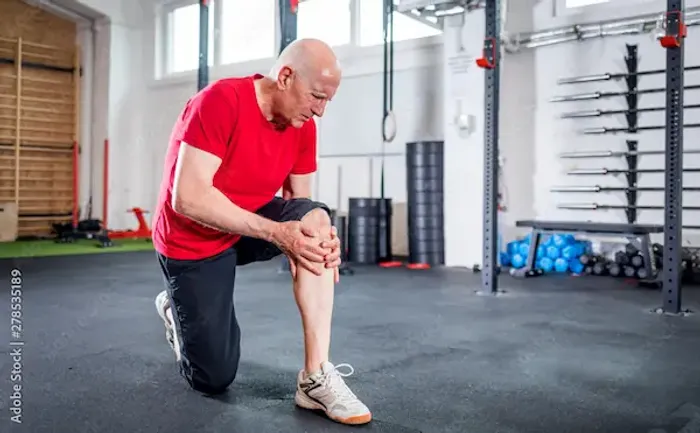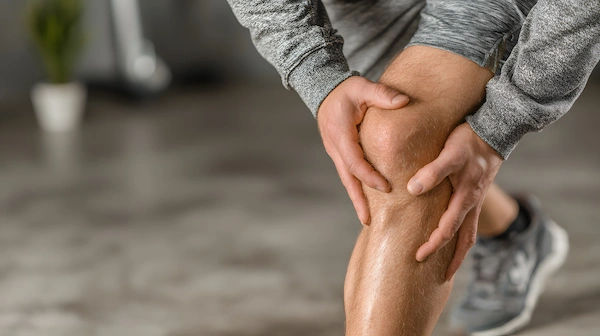Guide to Joint Problems In Old Age
Joint problems in older adults are common and often disabling, affecting mobility, independence, and quality of life. This detailed guide explains the causes, symptoms, diagnosis, and evidence-based treatments for joint disorders in old age. Learn about lifestyle strategies, medical therapies, diet, supplements, and when surgery is appropriate.


Introduction
Joint problems in older age significantly affect daily living by impacting mobility, comfort, and physical confidence. Stiff knees, painful hips, swollen fingers, and aching shoulders can develop gradually over years or present suddenly after strain, making it challenging to differentiate age-related change from disease. This comprehensive guide outlines why joint issues increase with ageing, common disorders, diagnostic approaches, lifestyle interventions, and available medical and surgical treatments. It also covers dietary measures, supplements, home adaptations, and the role of digital healthcare, including teleconsultations with Apollo24|7. Each section is designed to assist informed decision-making while promoting functional independence and long-term musculoskeletal health.
Consult a Top General Practitioner for Personalised Advice
Understanding Joint Problems in Older Adults
Joint pain, stiffness, and reduced mobility commonly arise with ageing.
Joint conditions affecting older adults are primarily associated with degenerative changes, chronic inflammation,
metabolic influences, and altered biomechanics. Globally, musculoskeletal conditions are among the leading causes of
disability. Knees, hips, spine, and small joints of the hands and feet are particularly vulnerable. Mobility impairment
increases risks of falls, dependence on caregivers, social withdrawal, and emotional distress.
Degenerative changes in joint tissues accumulate gradually due to a lifetime of load-bearing activities. Additionally, co-
existing chronic diseases — including cardiovascular disease, diabetes, and obesity — can exacerbate symptoms. Many
older adults also experience delayed recovery following minor injuries, which accelerates joint deterioration.
A clinically relevant concept is to assess pain severity alongside function and participation in meaningful activities. The
goal of management extends beyond pain reduction to maintaining autonomy — including walking, performing
household tasks, and engaging socially.
Interventions targeting strength, weight distribution, gait mechanics, and environmental modifications collectively
improve outcomes.
Common Conditions Causing Joint Problems in Old Age
Multiple joint pathologies contribute to functional decline in the elderly population.
Osteoarthritis (OA)
OA is the predominant cause of age-related joint pain. It involves progressive breakdown of articular cartilage,
subchondral bone changes, and synovial inflammation. Symptoms intensify with repetitive use and typically improve
with rest. Knees and hips cause difficulties during weight-bearing movements such as stair climbing, prolonged standing,
and rising from chairs. Hand involvement particularly affects the thumb base and finger joints.
Inflammatory Arthritis
Rheumatoid arthritis (RA) and psoriatic arthritis are chronic autoimmune disorders producing joint swelling, prolonged
morning stiffness, and structural damage. Although RA often begins earlier in life, late-onset presentations are well
recognised. Early initiation of disease-modifying therapies protects long-term function and prevents deformity.
Crystal Arthropathies
Gout, caused by monosodium urate crystal deposition, frequently results in acute red, hot, and intensely painful joints.
The first metatarsophalangeal joint is commonly involved, but knees, ankles, and wrists are also susceptible. Calcium
pyrophosphate disease (CPPD or pseudogout) resembles gout and often affects the knee, causing recurrent flares and
functional limitation.
Bursitis and Tendon Disorders
Inflammation of bursae or degenerative tendon changes — such as rotator cuff disease — cause localised pain aggravated
by specific movements or sustained loading.
Septic Arthritis (Emergency)
An acutely painful, swollen joint accompanied by fever or systemic illness suggests infection requiring urgent care. Rapid
diagnosis and antibiotic therapy are critical to preventing irreversible cartilage destruction.
Why Joints Hurt With Age: The Science Made Simple
Age-related joint pain results from tissue degeneration, muscle loss, and metabolic influences.
Degenerative and Inflammatory Tissue Changes
With advancing age, cartilage loses strength and elasticity. Synovial membrane inflammation contributes to further tissue breakdown, while osteophytes (bone spurs) form in response to instability. These mechanisms collectively generate mechanical pain and restricted movement.
Muscle Weakness and Altered Biomechanics
Sarcopenia — the age-related loss of muscle mass and power — reduces joint protection. Quadriceps and hip muscle
deficits contribute to knee malalignment and instability, increasing articular stress. Adaptive movement patterns may
overload unaffected joints, gradually expanding the pain distribution.
Systemic and Environmental Factors
Obesity adds both mechanical stress and inflammatory burden. Poor sleep, stress, and low mood heighten pain
perception via central sensitisation. Weather fluctuations may transiently influence joint swelling and discomfort, although mechanisms remain under investigation.
Optimising muscle strength, metabolic health, and sleep quality improves pain regulation and delays disability
progression.
Symptoms, Red Flags, and Diagnosis
Accurate assessment of joint symptoms guides appropriate early management.
Common Clinical Presentations
- Osteoarthritis: Pain during activity, morning stiffness under 30 minutes, bony enlargements, and instability
- Inflammatory arthritis: Prolonged stiffness, warmth, symmetrical swelling, systemic symptoms
- Crystal arthritis: Sudden severe pain with redness and swelling, recurrent flares
- Tendon/Bursal pathology: Focal tenderness and pain provoked by specific motion
Red Flags Requiring Urgent Review
- Fever with a hot, swollen joint
- Acute inability to bear weight
- Neurological deficit with back pain
- Unexplained night pain or weight loss
Diagnostic Evaluation
- History and Examination: Functional assessment, gait analysis, joint alignment, and swelling patterns
- Imaging: X-rays for degenerative changes; ultrasound for effusions or crystal deposits; MRI for soft-tissue involvement
- Laboratory Tests: ESR, CRP, uric acid, rheumatoid antibodies; joint aspiration where crystal or infective pathology is suspected
Apollo 24|7 provides convenient home blood collection for tests such as vitamin D, HbA1c, ESR/CRP, and uric acid — particularly useful when mobility is limited.
Lifestyle First: Movement, Weight, and Daily Habits
Lifestyle modification remains a cornerstone of joint management in older adults.
Evidence consistently supports targeted exercise to alleviate pain and improve function. Strengthening protocols for
quadriceps, hip abductors, and core musculature enhance joint support. Low-impact aerobic exercise improves
endurance and cardiovascular health without excessive load. Regular balance training reduces risk of falls — a critical
determinant of long-term independence in ageing populations.
Weight control substantially reduces mechanical stress on weight-bearing joints. Even modest reductions in body mass
significantly lessen knee compression forces during walking.
Home strategies such as heat for pre-activity warm-up and ice for flare management support comfort. Pacing strategies help maintain activity without provoking symptom exacerbation.
Supportive footwear, appropriate assistive devices, and ergonomic adjustments in daily routines minimise joint strain.
Medications, Injections, and Medical Treatments
Pharmacological and interventional therapies are selected based on type and severity of joint pathology.
Analgesics and Anti-Inflammatory Agents
- Paracetamol: Modest benefit for mild OA pain; dose optimisation and safety monitoring required
- NSAIDs: Effective for pain and stiffness but require cautious use due to gastrointestinal, renal, and cardiovascular risks
- Topical NSAIDs: Recommended first-line for knee and hand OA because of reduced systemic exposure
- Duloxetine: Appropriate for chronic musculoskeletal pain when psychological factors coexist
Specific Disease Therapies
- RA: DMARDs and biologic agents reduce inflammation and prevent joint destruction
- Gout: Acute attacks managed with NSAIDs, colchicine, or corticosteroids; long-term urate-lowering therapy prevents recurrences
Injections
- Corticosteroids: Short-term symptom relief, particularly for knee and shoulder disorders
- Hyaluronic acid: Possible benefit in selected knee OA patients; effect size variable
Complementary Options
Physical therapy programmes tailored to deficits in strength, balance, and biomechanics are essential across all disease types. Adjunct interventions such as acupuncture may offer additional relief for some patients. Bracing and orthotic devices maintain alignment and improve function during activity.
If symptoms remain uncontrolled, a physical consultation with a clinician at Apollo24|7 is recommended to optimise the
treatment strategy.
Food, Supplements, and Bone Health
Nutrition supports musculoskeletal health by modulating inflammation, supporting muscle mass, and maintaining bone
integrity.
Dietary Considerations
A Mediterranean-style dietary pattern, rich in plant-based foods and healthy fats, provides anti-inflammatory benefits and supports cardiovascular function — an important consideration when NSAID use is limited. Adequate protein intake distributed throughout the day helps sustain muscle mass alongside resistance exercise.
Evidence-Based Supplement Use
- Omega-3 fatty acids: Beneficial in inflammatory arthritis; modest effect in OA
- Turmeric (curcumin): Potential for reduced pain severity in some individuals
- Glucosamine/chondroitin: Mixed outcomes; possible benefit in hand OA
- Vitamin D and Calcium: Essential for bone health; supplement only with deficiency or inadequate dietary intake
Falls prevention combining nutritional support and specific balance and strength training significantly reduces fracture risk in vulnerable individuals.
Devices, Home Modifications, Technology — and When to Consider Surgery
Functional decline may be mitigated with supportive devices and tailored environmental adaptations.
Assistive Equipment
- Canes: Offload painful hips and knees; correct usage is essential for effectiveness
- Braces: Improve stability and correct malalignment in knee OA
- Footwear: Cushioned, well-fitted shoes improve gait mechanics
Home Safety Enhancements
- Grab rails, non-slip mats, elevated seating, and removal of trip hazards meaningfully reduce fall risk.
- Night lighting and safe shower setups enable safe independent living.
Digital Support and Telehealth
Wearable devices and mobile apps facilitate exercise adherence, progress monitoring, and early detection of symptom aggravation. Teleconsultations with Apollo24|7 enable follow-up reviews, medication adjustment, and coordinated diagnostics without travel burden.
Surgical Intervention
Joint replacement surgery is considered when non-operative management fails to provide adequate relief and mobility
becomes severely restricted. Hip and knee arthroplasty provide reliable improvements in pain and function, enabling sustained independence in daily life. Prehabilitation focusing on muscle strength and balance enhances postoperative recovery outcomes.
Conclusion
Joint problems in older adults are common but manageable through comprehensive care. Early recognition, lifestyle modification, appropriate pharmacological therapy, and strategic use of assistive equipment can substantially improve quality of life. When degenerative disease severely limits daily function despite the best conservative measures, surgical interventions such as joint replacement offer excellent long-term outcomes. Ongoing communication with healthcare professionals and tracking symptom progression empower informed decision-making. For symptom monitoring, specialist guidance, or diagnostic testing with home sample collection, Apollo 24|7 offers effective and accessible support aimed at maintaining independence, mobility, and well-being.
Consult a Top General Practitioner for Personalised Advice
Consult a Top General Practitioner for Personalised Advice

Dr. Bhethala Sharan Prakash
General Physician/ Internal Medicine Specialist
5 Years • MBBS MD
Bengaluru
PRESTIGE SHANTHINIKETAN - SOCIETY CLINIC, Bengaluru

Dr. Dayanashre N
General Physician
3 Years • MBBS
Bengaluru
PRESTIGE SHANTHINIKETAN - SOCIETY CLINIC, Bengaluru

Dr. Arif Ahmed
General Physician/ Internal Medicine Specialist
9 Years • MBBS, MD (Genl. Med.)
Kolkata
MCR SUPER SPECIALITY POLY CLINIC & PATHOLOGY, Kolkata

Dr. Rupam Chowdhury
Orthopaedician
10 Years • MBBS, DNB (Ortho.)
Kolkata
MCR SUPER SPECIALITY POLY CLINIC & PATHOLOGY, Kolkata

Dr. Anand Ravi
General Physician
2 Years • MBBS
Bengaluru
PRESTIGE SHANTHINIKETAN - SOCIETY CLINIC, Bengaluru
Consult a Top General Practitioner for Personalised Advice

Dr. Bhethala Sharan Prakash
General Physician/ Internal Medicine Specialist
5 Years • MBBS MD
Bengaluru
PRESTIGE SHANTHINIKETAN - SOCIETY CLINIC, Bengaluru

Dr. Dayanashre N
General Physician
3 Years • MBBS
Bengaluru
PRESTIGE SHANTHINIKETAN - SOCIETY CLINIC, Bengaluru

Dr. Arif Ahmed
General Physician/ Internal Medicine Specialist
9 Years • MBBS, MD (Genl. Med.)
Kolkata
MCR SUPER SPECIALITY POLY CLINIC & PATHOLOGY, Kolkata

Dr. Rupam Chowdhury
Orthopaedician
10 Years • MBBS, DNB (Ortho.)
Kolkata
MCR SUPER SPECIALITY POLY CLINIC & PATHOLOGY, Kolkata

Dr. Anand Ravi
General Physician
2 Years • MBBS
Bengaluru
PRESTIGE SHANTHINIKETAN - SOCIETY CLINIC, Bengaluru
More articles from Joint Pain
Frequently Asked Questions
1) What are the best exercises for arthritic knees in older adults?
Strengthening of quadriceps and hip muscles, low-impact aerobic exercise, and targeted balance drills are recommended. Frequency and consistency are crucial.
2) When should a doctor be consulted for joint pain in old age?
If pain persists beyond two weeks, interferes with sleep or mobility, or is associated with swelling or warmth. Urgent assessment is required for fever with a hot swollen joint.
3) Do supplements like glucosamine and chondroitin work?
Clinical evidence varies, though some individuals report mild benefits with hand or knee OA after regular use for several months.
4) Are topical gels effective for knee pain?
Yes — topical NSAIDs are strongly supported for knee and hand OA due to favourable safety profiles in older adults.
5) How is the need for joint replacement determined?
Surgery is considered when pain persists despite comprehensive non-surgical care and significantly impairs daily function and sleep.




